Whether you want to build a bigger chest or just tone and shape your pecs, choosing the right machines is important. For gym-goers looking to build a stronger, more defined chest, utilizing chest workout machines can be an efficient and effective part of your training regimen.
Chest machine exercises not only strengthen the chest muscles, but they also help develop upper body strength and improve posture over time.
So, how do you develop that strong, well-sculpted chest? Gym machines designed for chest workouts can be your best allies. They allow you to target different muscle groups effectively and work on your weak points.
Chest machines allow you to safely lift heavier weights, isolate specific areas of the chest, and get more from your workouts.
Machines provide stabilization, allow you to isolate specific chest muscles, and often permit you to use heavier resistance than with free weights alone.

- Top Gym Machines For Chest Workouts With Exercises
- 1. Seated Chest Press Machine
- 2. Pec Deck Machine
- 3. Cable Crossover Machine
- 4. Smith Machine For Chest Workout
- 5. Chest Dip Machine
- 6. ISO Incline Press
- 7. Decline Chest Press Machine
- FAQs
- Are machines effective for chest?
- What machine hits the lower chest?
- Conclusion
Top Gym Machines For Chest Workouts With Exercises
A strong, sculpted chest is a key fitness goal for many gym-goers. While free weights like barbells and dumbbells are effective tools, it is important to consider chest workout machines when developing your chest training regimen.
Machines help keep muscles stable, make moving around easier, and make lifting heavier things safer. Here are 10 gym machines that you can use for a chest workout:
1. Seated Chest Press Machine
The chest press machine is one of the most popular pieces of gym equipment designed to work the chest muscles. The machine generally consists of a seat, a backrest, and a set of handles aligned with your chest level.
Unlike free weights, this exercise provides a guided motion, facilitating a more focused focus on the chest muscles without worrying about balance or control. The machine is often adjustable, so you can work from different angles to engage different chest parts.
With the chest press machine, you can easily perform multiple sets and reps, using different weights and resistance levels, and incorporating drop sets or supersets.
Seated Chest Press machines by Other Names such as vertical chest press machines.
Muscle Worked
- The chest press machine primarily targets the chest muscles (pectoralis major and minor),
- It also works the triceps, shoulders (deltoids), and back (latissimus dorsi) muscles to some degree.
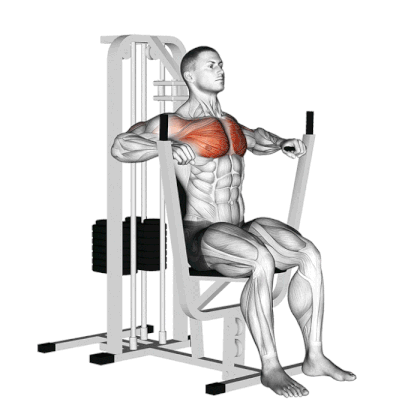
How Does It Work?
- Set an appropriate seat height and setback position.
- Maintain retracted shoulder blades to prevent injury and maximize muscle activation.
- Grasp the handles or levers with a neutral grip/overhand grip.
- Press along the path of the movement of arms, keeping the elbows close to the body.
- Exhale as you push the handles or levers forward, and then inhale as you return to the starting position.
2. Pec Deck Machine
Have you ever wondered how the machine chest fly can help maximize your chest muscle growth? It’s not just about using a machine to target your chest muscles, but the science behind the exercise that makes all the difference.
The Pec Deck Machine, also called the machine chest fly, is designed to work on the chest muscles. It consists of a seat with a backrest and two arm pads or handles on each side.
Unlike the Chest Press Machine, which involves a pushing action, the Pec Deck Machine focuses on horizontal arm adduction, meaning you bring your arms close together in front of you. It creates tension in your chest muscles, which causes them to contract and grow.
The angle at which you perform the machine chest fly can impact the targeted muscles, such as the upper, middle, and lower chest.
- By placing your hands at chest level, you can effectively target all chest muscles equally. (Best One)
- One can effectively target the lower chest muscles by placing their hands below the chest level on the handles.
- Positioning your hands above the chest level on the handles of the Pec Deck machine puts more focus on the upper chest muscles.
Machine Chest Fly Vs. Pec Deck Fly
Both the chest fly machine and the pec deck primarily focus on the chest. They are effective exercises to build a bigger and stronger chest. But there are a few differences between the chest fly machine and the pec deck
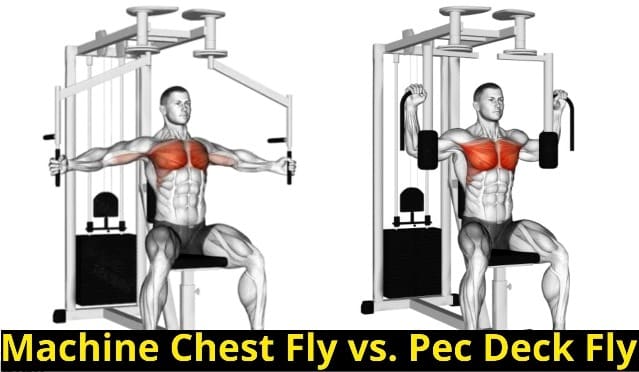
1. Machine Chest Fly
- The machine chest fly is performed using straight elbows. The open position allows for greater stretch, which can lead to enhanced muscle growth.
- It offers a greater range of motion at the open position than the pec deck.
2. Pec Deck Fly
- The pec deck machine provides a greater range of motion in the finished, pad’s closed position. This makes the elbows closer, making the inner chest muscles work harder.
- Pec decks can be used with heavier loads than chest fly machines. This can help increase strength and challenge the muscles further.
Muscles Worked
- Primary Muscle Worked: Pectoralis Major
- Secondary Muscle Worked: Pectoralis Minor, Serratus Anterior, Anterior Deltoids
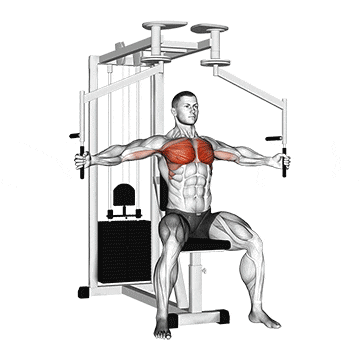
How Does It Work?
- Adjust the seat so that the arm pads are at chest level. Make sure your feet are flat on the floor for stability.
- Sit down and place your back firmly against the backrest. Grab the vertical handles with elbows slightly bent.
- With a neutral grip, open your arms out to the sides. Your arms should be in line with your chest and slightly bent at the elbows.
- Exhale and bring the handles together in front of your chest.
- Slowly open your arms back to the starting position while inhaling, letting your chest muscles stretch fully.
- Perform the recommended number of repetitions and sets as per your workout plan.
3. Cable Crossover Machine
The Cable Crossover Machine is a versatile piece of gym equipment with two adjustable cable pulleys on either side. Unlike other chest workout machines, which have fixed paths of motion, the Cable Crossover allows for a wide range of movements.
The cable chest fly or crossover exercises are a great way to strengthen and shape your chest area.
You can adjust the height of the pulleys and the position of the handles to target different chest areas.
Additionally, the cable crossover provides a versatile range of motion, allowing you to adjust the height and angle of the cables to target different areas of the chest. Such as:
- Middle Crossover: Specially target the inner chest
- Low Cable Fly: Specially target the Upper Chest
- High Cable Fly: Specially target the Lower Chest
Muscle Worked
The cable crossover primarily targets the chest muscles, particularly the pectoralis major. In addition to the chest, other muscle groups are involved as stabilizers and synergists during the exercise.
- Anterior deltoid,
- Serratus anterior
- Biceps Brachii,
- Trapezius
- Rhomboids
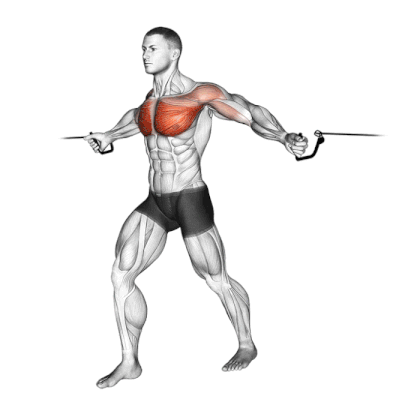
How Does It Work?
- Set the cable machine’s handles at a mid-level, usually around shoulder height.
- Stand in the middle of the cable machine with your feet shoulder-width apart, knees slightly bent, and hips leaning forward.
- Hold one handle in each hand and make sure to hold it tightly.
- Position your arms out to the sides, parallel to the floor, and bend your elbows slightly.
- Bring your hands together in front of your body or cross them at the midline.
- As you bring the handles together, concentrate on squeezing your chest muscles and maintaining tension.
- Return to the starting position slowly and with control.
4. Smith Machine For Chest Workout
The Smith Machine can effectively target your chest muscles, especially if you’re looking for a more controlled environment to perform bench presses or other chest exercises. It consists of a barbell fixed within steel rails, allowing only vertical or near-vertical movement.
It provides added stability and safety, making it an excellent option for those looking to focus solely on muscle engagement without worrying about balancing the weight. The Smith machine chest press is similar to a barbell bench press, but it provides more stability and control.
There are many variations of bench press that you can do with the Smith machine, and each one targets different regions of the chest (upper, lower, and inner)
- Smith Incline Bench Press: Set the bench at a 30-45 degree incline to target the upper chest more effectively.
- Decline Smith Bench Press: Targets lower chest by declining bench to 15–30 degrees.
- Close-grip bench Press: Place your hands closer together on the bar. This will emphasize the inner and triceps muscles.
- Wide Grip Bench Press: Grip the bar wider than shoulder-width apart. This exercise targets the outer chest and shoulders.
- Reverse Grip Smith Machine Bench Press: Underhand (supinated) grip on the bar. It places more emphasis on the tricep and upper chest muscles.
Muscle Worked
- It is a compound exercise that works for multiple muscle groups simultaneously.
- The Smith machine primarily targets the pectoralis major muscle of the chest, along with the triceps and shoulders.
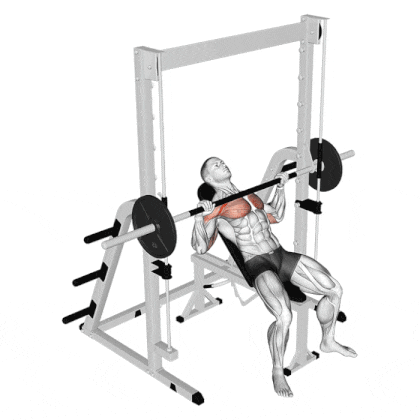
How Does It Work
- Set up an adjustable bench beneath the Smith Machine’s barbell at the desired angle (flat, incline, or decline).
- Lie on the bench and position yourself so that the barbell aligns with your chest.
- Grip the barbell with your hands slightly wider than shoulder-width apart.
- With a controlled motion, lower the barbell toward your chest.
- Push the barbell back to the starting position by fully extending your arms. This contracts your chest muscles.
5. Chest Dip Machine
The chest dip machine is a machine-based exercise that mimics a triceps dip, a bodyweight exercise performed on parallel bars or on a pull-up and dip station. The machine typically consists of two parallel bars or handles that are attached to a weight stack.
The Assisted chest dip machine is a great way to train lower chest muscles, and it can be especially useful for those who find body-weight dips challenging.
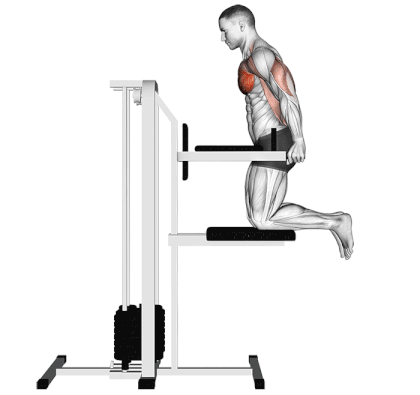
Muscles Worked
The Chest Dip is a compound exercise that works multiple muscle groups simultaneously.
- The primary muscles worked are the pectoralis major and minor (chest).
- Secondary muscles worked include the front deltoids, triceps, and serratus anterior.
How Does It Work
- Grasp the handles with an overhand grip and keep your elbows in at your sides.
- As you contract the chest muscles, push down on the handles, lowering your body towards the floor.
- At the bottom of the movement, focus on keeping your arms slightly bent to keep tension on the chest muscles.
- Slowly push back up, squeezing the chest muscles.
6. ISO Incline Press
For optimal chest development, focus on these two key principles in your training:
- Prioritize building the upper chest area to create impressive upper pec mass and shape.
- Train each side of the chest independently to correct muscle imbalances.
The iso-lateral incline chest press machine is ideal for both of these goals. The inclined press targets the upper pectorals to build size and fullness. The separate arm handles allow you to isolate each side and provide additional focus to your weaker pec to promote symmetry.
Muscles Worked
- The primary muscle targeted is the chest muscle, focus more on the upper chest.
- Secondary muscles worked include anterior deltoids, triceps, and serratus anterior.
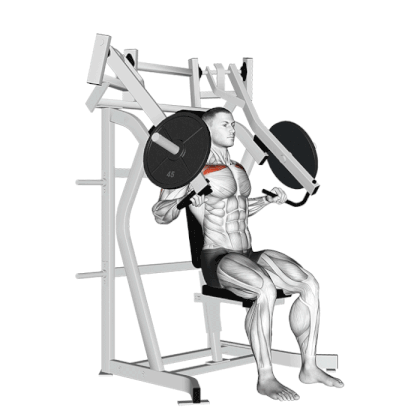
How Does It Work
- Sit securely in the machine and select the weight.
- Grasp the handles or levers with an overhand grip and keep your elbows in at your sides.
- As you contract the chest muscles, push forward on the handles or levers, squeezing the chest muscles.
- Slowly release the handles or levers back to the starting position.
7. Decline Chest Press Machine
The machine decline chest press is a strength training exercise that primarily targets the pectoralis major (lower chest), anterior deltoids, and triceps.
The decline machine press can be easier on the shoulder joints than the incline press because the downward angle puts less stress on the shoulder rotator cuff.
The machine’s guided motion helps you keep your form and reduce the risk of dropping weights or losing control.
Muscles Worked
- The decline machine chest press primarily targets the chest muscles (pectoralis major and minor), mainly the lower chest.
- The secondary muscles that work during this are the tricep brachii and anterior deltoid.
- Several stabilizing muscles, such as the serratus anterior, rotator cuff, core, and trapezius, also work during it.
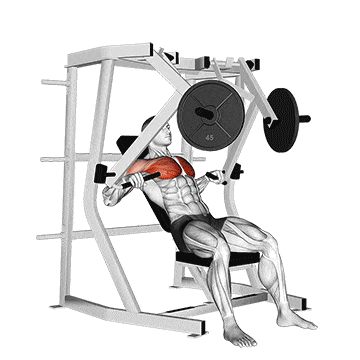
How Does It Work
- Sit upright with your back flat against the pad and your feet firmly planted on the floor.
- Grab the handles with an overhand grip, slightly wider than shoulder-width apart.
- Your hands should be in line with your chest, and your elbows should be slightly below shoulder level.
- Exhale and slowly lower the handles towards your lower chest in a controlled motion.
- Keep your elbows tucked in at around a 45-degree angle relative to your torso.
- Inhale and press the handles back to the starting position by straightening your arms, but don’t lock your elbows at the top.
Know More: 10 Best Gym Back Workout Machines To Build Mass and Strength
FAQs
Are machines effective for chest?
Yes, machines can help you work out your chest muscles. They give you a safe and controlled environment that can be helpful for people who are new or want to work on specific parts of the chest. Also, they have added safety features, so you can work out without a spotter.
What machine hits the lower chest?
The machine that hits the lower chest is the decline chest press machine and Chest Dip Machine.
The Decline Chest Press machine is a weight machine that allows you to perform chest presses while lying at a 30-—to 45-degree angle. This angle emphasizes the lower chest muscles.
Conclusion
Gym machines can help you build a stronger, more muscular chest, improve pushing power, and reduce the risk of shoulder injuries. Different machines and variations can help shift focus between upper chest and lower pecs to achieve your chest development goals.
Some of the most popular gym machines for chest workouts include the chest press machine, pec deck fly, cable crossover, and Smith machine bench press. Furthermore, you can use the dip machine to complete a chest workout.
Machines isolate the chest muscles by providing fixed paths of movement. Adjustable seats, handles, and lever arms allow you to target different chest areas.
Lighter controlled reps enhance muscle isolation and build strength with heavier weights. Combining chest machines with free weight presses and fly workouts can create a sculpted, muscular chest.

Manish is a NASM-certified fitness and nutrition coach with over 10 years of experience in weight lifting and fat loss fitness coaching. He specializes in gym-based training and has a lot of knowledge about exercise, lifting technique, biomechanics, and more.
Through “Fit Life Regime,” he generously shares the insights he’s gained over a decade in the field. His goal is to equip others with the knowledge to start their own fitness journey.
